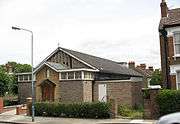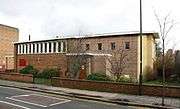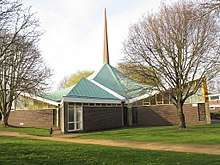Ralph Covell
Ralph George Covington Covell (6 May 1911 – 16 December 1988) was an English modern architect, active during the post-war period to the early 1970s.
Ralph George Covington Covell | |
|---|---|
| Born | 6 May 1911 |
| Died | 16 December 1988 (aged 77) |
| Nationality | British |
| Occupation | Architect |
| Spouse(s) | Marguerite Latter Lurline Knowles |
| Children | two sons |
| Parent(s) | George William Covell and Elsie Covington |
| Awards | Ashpitel Prize MBE |
| Practice | Covell & Matthews Covell Matthews and Partners |
| Projects | Piccadilly Plaza, Manchester (1959–1964) |
Early life and family
Ralph was born in Lee, London, on 6 May 1911, the son of George William and Elsie Covell née Covington.[1] The family lived in Lee High Road in the 1930s[2]
In late 1935 Ralph married Marguerite Latter but, after World War II, they had separated and both remarried.[3][4] Covell married Lurline Stanley Knowles (1913 – 2005) in 1947.[5][6]
Early career and military service
Covell won the Ashpitel Prize in 1934 and was admitted ARIBA the following year.[7] Covell founded an architectural practice in 1937 in Westminster where he worked until drafted into the Army. During this period he taught architecture at Croydon College of Art.[8]
During World War II he served with the Royal Engineers and was promoted to the rank of second lieutenant in 1940.[7][9] He was evacuated from Dunkirk and later posted to Orkney where he was involved in the defences of Scapa Flow. After being recalled to London he was posted to the British Military Attaché in Washington, where he stayed until the end of the war.[10]
Post-war career
.jpg)
After the war he resumed architectural practice, and was elected FRIBA in 1946.[7] Covell was joined by Albert Edward Thurman "Gerry" Matthews in 1948 to form "Covell & Matthews".[11] Matthews had also served in the Royal Engineers, seeing service in Italy and the Western Front.[10] They acquired work with the Ministry of Defence allegedly due to Marshall's wartime acquaintance with Montgomery. This work included contracts in Gibraltar during which time Albert Heasman joined the practice as a senior partner.[12][13]
Matthews' connections with developers led to their first major contract, part of the 1959 redevelopment of the Piccadilly Gardens area of Manchester City Centre, which led to the practice opening an office in Manchester.[10] The firm developed 'Piccadilly Plaza', a group of three buildings linked by a podium. The tallest, an office block originally called 'Sunley Tower', features a textured design on one side evoking circuit boards. The second, originally the 'Ramada Manchester Piccadilly' is a hotel. The third, 'Bernard House' featured a unique roof described as "timber structure of hyperbolic paraboloid form, comprising of a main rib element on each of the four axes of twin Glulam Beams" but was demolished in 2001.[14] The Piccadilly Plaza is now considered by some to be an exemplar of modernist architecture.[15]
By 1960 the practice had become "Covell Matthews and Partners" and it expanded rapidly over the following decade, with Brian Falk and John Wheatley joining the practice during this period.[10] By 1970 they had offices in Edinburgh and Aberdeen whilst Covell himself mostly remained based at the Lexington Street office in Soho.[8][11][16] Covell himself was elected FRIAS in 1965.[17] During this period the practice was associated with many buildings in Scotland and included the McCance building (1962–3) and Alec House (1963-68) now part of the University of Strathclyde and the brutalist John Lewis store in Aberdeen (1968–70).[18][19][20][21] However work in England continued including the residential estate at Bar Hill, Cambridge, and a pub in West Ham in 1968.[8]
Although Covell retired in 1972, the practice continued as the "Covell Matthews Partnership" and continued to evolve thereafter.[17]
Churches
Covell undertook work on several churches, predominately on behalf of the Diocese of Southwark where the practice is associated with 23 church buildings.[8] One early post-war project was war-damage reconstruction of Holy Cross, Motspur Park, originally built in 1908, where Covell undertook reconstruction and repair work in 1948.[22][23] In 1956 Covell designed St Agnes, Kennington Park as a replacement of the original 1874-7 G. G. Scott church following its demolition due to bomb-damage. Covell's church included a baptistry beneath a west gallery; north-east lady chapel; vestries and office/meeting room accessed via corridors and a hall complex all set in a small churchyard.[24][25] A more modest project was the 1958 parish hall in Charlton, London on the site of the former Sundorne Mission Hall in Swallowfield Road, used by St Luke with Holy Trinity church.[26]
The church of St Matthew, Camberwell, was also a Covell-designed replacement for a previous church in Denmark Hill that had mostly been destroyed during a bombing raid on 26 September 1940. Building work commenced in 1959 and completed in 1960.[27][28]
St. Katharine with St. Bartholomew Church, South Bermondsey, built in 1960, replaced a former church, bomb-damaged in 1940 and demolished in the late 1950s. Covell's design re-used the basement of the former church. It features zig-zag walls around the nave, a copper covered nave roof, with abstract dalle de verre windows by W. T. Carter Shapland.[29][30]
Covell continued the use of dalle de verre and copper roofing at St Richard's Church, Ham, completed in 1966. The church features a Star of David plan creating a hexagonal central space for worship and a matching hexagonal font.[31]
Covell continued the open interior and copper roof themes with the octagonal William Temple church, Abbey Wood, also built in 1966. Again, Covell also designed the font.[32]
The church of St Lawrence, Catford, built in 1967-8, repeated these themes: an octagonal church with peripheral vestries and other ancillary rooms and a pentagonal Lady Chapel also used as a community centre. Both have exposed reinforced concrete frames which continues over the church to form a corona, and to a spirelet with a single bell over the chapel.[33] The church also features further dalle de verre work by W. T. Carter Shapland. The buildings were listed Grade II in 2010.[34]
Covell was a keen organist, playing at St Agnes, Kennington Park.[8][35] He was also involved in the replacement of the organ in the Royal College of Organists in 1967.[36]
.jpg) St Agnes, Kennington Park
St Agnes, Kennington Park St Richard's church and hall, Charlton
St Richard's church and hall, Charlton St Matthew, Lilford Road, Camberwell
St Matthew, Lilford Road, Camberwell.jpg) St Katharine with St Bartholomew, Eugenia Road, Bermondsey
St Katharine with St Bartholomew, Eugenia Road, Bermondsey
.jpg) William Temple Church, Abbey Wood
William Temple Church, Abbey Wood.jpg) St Laurence, Bromley Road, Catford
St Laurence, Bromley Road, Catford
Retirement and death
Covell retired in 1972.[11] During the 1980s he served as governor and chairman of St Clement Danes School, Hertfordshire and was awarded the MBE in 1985.[37] He died in Crowborough, East Sussex on 16 December 2008, aged 77.[38]
References
- "George William Covell in the British Army WWI Service Records, 1914-1920". Retrieved 17 April 2018 – via Ancestry.com.
- "Ralph George Covell in the London, England, Electoral Registers, 1832-1965". Electoral Registers. London, England: London Metropolitan Archives. Retrieved 17 April 2018 – via Ancestry.com.
- "Index entry". FreeBMD. ONS. Retrieved 17 April 2018.
- "Index entry". FreeBMD. ONS. Retrieved 17 April 2018.
- "Index entry". FreeBMD. ONS. Retrieved 17 April 2018.
- "Lurline Stanley Covell". England & Wales, Civil Registration Death Index, 1916-2007 – via Ancestry.com.
- "Ralph George Covington Covell". Dictionary of Scottish Architects. Retrieved 17 April 2018.
- "Architects & Artists C". Retrieved 17 April 2018. citing: "Obituary". RIBA Journal (96): 104. March 1988.
- "No. 34793". The London Gazette (y). 16 February 1940. p. 997.
- "Covell Matthews & Partners". Retrieved 17 April 2018.
- "Covell Matthews & Partners". Dictionary of Scottish Architects. Retrieved 17 April 2018.
- "History of number 11A Streatham Common South". Streatham Common Environmental Co Operative. 27 February 2013. Retrieved 17 April 2018.
- "Official Architecture at the Royal Academy". Official Architecture and Planning. Alexandrine Press. 23 (5): 225–227. May 1960. JSTOR 44128701.
- "Best of MCR...The Lost Buildings". Retrieved 19 April 2018.
- While, Aidan; Short, Michael (March 2011). "Place narratives and heritage management: the modernist legacy in Manchester". Area. 43 (1): 4–13. JSTOR 41240453.
- Covell, Ralph C (1968). "letters to the editor: the third london airport". Official Architecture and Planning. Alexandrine Press. 31 (3): 354. JSTOR 43963461.
- "Covell Matthews Partnership". Dictionary of Scottish Architects. Retrieved 17 April 2018.
- Historic Environment Scotland. "Glasgow, Richmond Street, University Of Strathclyde, Mccance Building (805018)". Canmore. Retrieved 20 April 2018.
- Historic Environment Scotland. "Glasgow, Richmond Street, Livingstone Tower, Strathclyde University (805017)". Canmore. Retrieved 20 April 2018.
- "Aberdeen Buildings: Aberdeenshire Architecture - e-architect". Retrieved 17 April 2018.
- Wright, oward (1 January 2014). "Power surge". RIBA Journal.
- "About the church - Motspur Park, Holy Cross". Retrieved 17 April 2018.
- "Motspur Park: Holy Cross - The Diocese of Southwark". Diocese of Southwark. Retrieved 17 April 2018.
- "Kennington Park: St Agnes - The Diocese of Southwark". Diocese of Southwark. Retrieved 17 April 2018.
- "Kennington Park, St Agnes - Southwark & Newington Deanery - The Diocese of Southwark". Diocese of Southwark. Retrieved 17 April 2018.
- "Former places of worship in the Diocese of Southwark" (PDF). Diocese of Southwark. Retrieved 17 April 2018.
- "Camberwell: St Matthew - The Diocese of Southwark". Diocese of Southwark. Retrieved 17 April 2018.
- "About the church - Camberwell, St Matthew". Retrieved 17 April 2018.
- "Bermondsey, St Katharine formerly Rotherhithe, St Katharine" (PDF). Diocese of Southwark. Retrieved 17 April 2018.
- "Bermondsey: St Katharine with St Bartholomew - The Diocese of Southwark". Diocese of Southwark. Retrieved 17 April 2018.
- About the Church, St Richards Church, Ham, 20 May 2010 (Information sheet)
- "About the Church Building - William Temple - A Church Near You". Retrieved 17 April 2018.
- "Catford: St Laurence - The Diocese of Southwark". Diocese of Southwark. Retrieved 17 April 2018.
- Historic England. "Church of St Laurence and Community Centre (1393742)". National Heritage List for England. Retrieved 17 April 2018.
- "Kennington Common | OpenBuildings". Retrieved 17 April 2018.
- Sheppard, F H W, ed. (1975), "Royal College of Organists", Survey of London, London: British History Online, 38, South Kensington Museums Area, pp. 217–219, retrieved 17 April 2018
- "No. 50361". The London Gazette (y). 30 December 1985. p. 12.
- "Ralph George C Covell in the England & Wales, Civil Registration Death Index, 1916-2007" – via Ancestry.com.